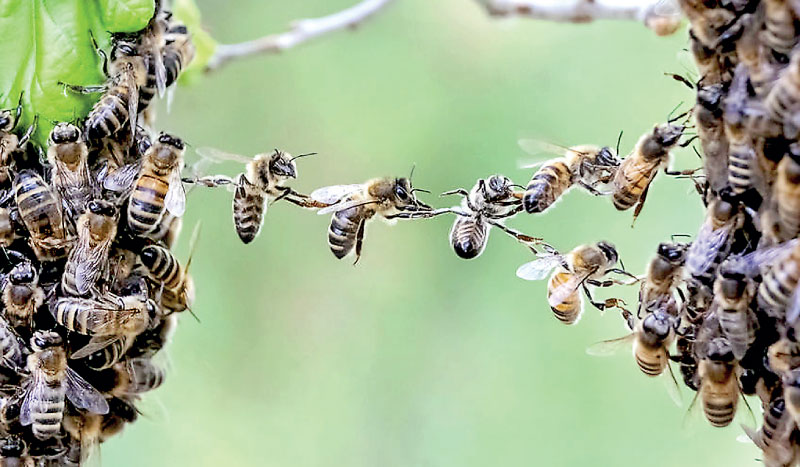Sunday Dec 14, 2025
Sunday Dec 14, 2025
Monday, 25 April 2022 00:15 - - {{hitsCtrl.values.hits}}

 The youth has come to the forefront, putting aside ethnic or religious differences. It is a clear sign of committed ‘communityship’ in action. The spellchecker would say there is no such word. It is refreshingly new. Henry Mintzberg, one of my all-time favourites, highlighted the significance of it in his book ‘simply managing’. Today’s column is an elaboration of it in relation to the chaotic Sri Lankan context.
The youth has come to the forefront, putting aside ethnic or religious differences. It is a clear sign of committed ‘communityship’ in action. The spellchecker would say there is no such word. It is refreshingly new. Henry Mintzberg, one of my all-time favourites, highlighted the significance of it in his book ‘simply managing’. Today’s column is an elaboration of it in relation to the chaotic Sri Lankan context.
Overview
Living in communities is nothing new for east and west alike. We have Sangha societies in the Buddhist context. We also have monasteries in the Christian context. The commonality in both is the way a group of members of a community is living. It involves sharing of a common set of values, respecting one another and a high degree of collaboration. Also, it invites the members to display synergy in their actions and reactions.
“We need to rethink management and organisation, beyond leadership to communityship, by realizing how simple, natural and healthy they can be”. So says Henry Mintzberg in the concluding sentence in his seminal book ‘Simply Managing’.
For me, management is a process and leadership is a phenomenon. Every manager has a ‘leading’ function to perform. When it gets expanded, he/she thinks and acts more as a leader. What Mintzberg invites us is even to go beyond. In his website blog (www.mintzberg.org), Mintzberg elaborates why he says so: “How can you recognize communityship? That’s easy. You have found it when you walk into an organization and are struck by the energy in the place, the personal commitment of the people and their collective engagement in what they are doing. These people don’t have to be formally empowered because they are naturally engaged. The organization respects them, so they respect it. They don’t live in mortal fear of being fired en mass because some “leader” hasn’t made his or her numbers. Imagine an economy made up of such organizations.” (www.mintzberg.org)
There is a clear invitation to shift from a “one man show” to a “one team show”. In other words, we need no one super star but a galaxy of super stars. I have been sub-consciously promoting this at the Postgraduate Institute of Management, and now I am more convinced when I hear the inspirational ideas from Mintzberg in a similar fashion.
Synergy and communityship
One key feature in communityship is synergy. Synergy is all about working together. It is synchronised energy in action. Stephen Covey, in his bestseller ‘Seven habits of highly effective people’, describes synergy as follows: “Synergy means that the whole is greater than the sum of its parts. It shows that the relationship, which the parts have to each other, is a part in and of itself. It is not only a part, but also the most catalytic, the most empowering, the most unifying, and the most exciting part.”
“Synergy is everywhere in nature”, he goes on further. “If two plants are placed close together for growth, the roots improve the quality of the soil so that both plants will grow better than if they were separated. In short, one plus one equals three or more. The challenge is to apply the principles of creative co-operation, which we learn from nature, in our social interactions…The essence of synergy is to value differences – to respect them, to build on strengths, to compensate for weaknesses”. There is much food for thought indeed.
“Probably we never fully credit the interdependence of wild creatures, and their cognisance of the affairs of their own kind”, so said Mary Austin, a renowned American author. The way geese fly in ‘V’ shape and the way wolves run as a flock are just two prominent examples.
Symbiosis as the basis
Synergy we see in nature is associated with the complex term symbiosis. It is close and often long-term interaction between two or more different biological species. In other words, a close prolonged association between two or more different organisms of different species that may benefit each member. Way back in 1877, Albert Bernhard Frank used the word symbiosis to describe the mutualistic relationship in lichens. It is also described as the living together of two dissimilar organisms, as in mutualism, commensalism, or parasitism.
The term, ‘symbiotic relationship’ is often used in the area of sociology. The word symbiosis has first been used to describe people living together in a community. It is, in fact, a true adaptation from the biological meaning of ‘living together of unlike organisms’.
Communityship through team effectiveness
As we saw, synergy is associated with working together. Teams and groups are often interchangeably used to describe a set of people working together. In perusing through the literature of Organisational Behaviour, veterans like Stephen Robbins and Fred Luthans have identified a group as a set of two or more individuals interacting and interdependent with each other in achieving a common objective. A team is one step ahead. I would simplify a team as a group with synergy.
We can get many examples from the field of sports. A sporting team is effective if it is consistently winning. What are the contributing factors for team effectiveness? I would propose four Cs in line with Stephen Robins’s recommendations. They are, combination, composition, context, and conduct.
Combination
This refers to work design. Whether the team members are having a set of specified tasks with needed autonomy to carry them out is important. For that to happen, tasks have to be well designed in with the set goals in mind. The team members should identify themselves with the tasks and see the significance of such tasks. In a cricket team, a wicket keeper should know exactly what his role is in order to win a game.
In the game of business, employees should be clear about why they do what they have to do, and how best they should do. A creative writer in an advertising team who has a sense of pride in his/her work with freedom to take decisions is one such example.
Composition
As we know, five fingers of a hand are different, yet they are all parts of the same hand. Diversity is a key factor of team effectiveness. Meredith Belbin did a fair amount of research on team roles and came up with nine different team roles. Ensuring that people with appropriate personalities fit to the required tasks is essential in this respect.
Flexibility of team members in moving beyond the specialised tasks for the betterment of team is another important aspect. A specialised bowler of a cricket team should be a good fielder and also a satisfactory batsman. That is all about flexibility. In a business setting, ability to attend a colleague’s duty in case of a need is handy with a true sense of multi-skilling.
Conduct
This is all about means to the end. Clarity of goals is one key aspect. There should not be any ‘social loafers’ as Stephen Robins call the category of people who are just ‘passengers’. Every team member should do their best in order to make their team the best team. The Sri Lankan Cricket team who won the world cup in 1996 is one such example.
Conflicts among the team members should be kept at a minimum level. Else, the process will not run smoothly towards the achievement of results. I have seen how egos of different team players clash in search of supremacy and dominance. Some find it difficult to give up in order for others to take over. The end result is inevitably a losing team.
Context
There has to be a climate of trust for team work to foster. Management, leadership and communityship all foster in such a setting. Right direction with required resources, a team would have the right forward journey.
It is amazing to see the demonstration of team work in action during the recent actions by youth showing their displeasure towards the current system. They in fact represent the vibrancy of centennials.
Centennials to the centre
Centennials represent the newest generation according to the classification of generations. They are also popularly called as generation Z. Though there are disputes of the stating year, centennials are supposed to be born between the years 2000 and 2020 with plus or minus 2-3 years variations. Some authors even refer to 1995 as the starting year of this generation.
One obvious factor among all these generations is that the very names are associated with events took place in the west, and to a very high extent in the USA. The degree of relevance and applicability to Asian countries such as Sri Lanka is questionable. Despite the criticisms of the nature of origin being very American, global acceptance of the presence of multiple generations is evident.
The millennials or generation Y employees who were born between 1980 and 1999 have differences in their perceptions, preferences, and performance. They are much more tech-savvy compared to their generation X predecessors, having exposed to rapid advancement in information and communication technology during past decades. They are also for more flexible work arrangements. Rigid eight hour work rule will make them bored and unproductive. They are also much more ecological conscious in going green. These triple aspects of tech-savviness, work flexibility and green-consciousness act as key indicators with regard to their preferences towards work arrangements.
Then comes centennials who are the newest entrants to the workplace. They were exposed to internet from day one of their life and obviously they are far more tech-savvy than millennials. Through research, Generation Z has already being identified as being curious, courageous, and creative. It’s being shown in how the communityship is being displayed in a peaceful protest, sustained by centennials.
Way forward
Communityship can be viewed as a way the east and west meet together. It’s practical nature and productive features should motivate us to embrace it as a sure fire way of achieving sustained results. It is an invitation to relate, reflect and reinforce how to act, react, and interact in fostering communityship. It will be a steady step towards a system change.
(The writer is the immediate past Director of the Postgraduate Institute of Management, and can be reached through [email protected], [email protected] or www.ajanthadharmasiri.info.)